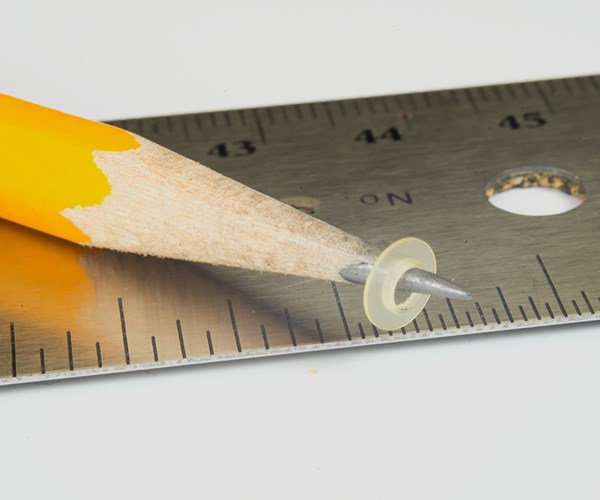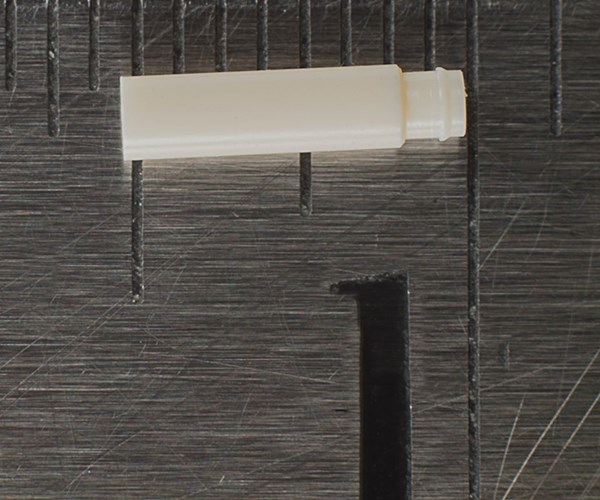Backing Tech with Technique
Whether in machining or any other pursuit, knowledge and the right touch are critical to taking full advantage of technology and equipment.

Tool sharpness is critical to avoiding burrs on plastic parts like this, but that’s more a function of strategy than technology.
Although technology is our focus, we editors of Modern Machine Shop are consistently reminded that even the most sophisticated equipment isn’t enough for success. This truism isn’t unique to machining or manufacturing, either.
Most recently, this point was driven home by an experience I had working on an article a few months back about Connecticut-based machine shop East Coast Precision Manufacturing, which specializes in small, plastic parts like the one above. Any good article needs good photography, but after trying for hours to focus on tiny part features to no avail, I decided my camera simply wasn’t capable of getting the right shots. So, I turned the parts over to Jeff Norgord, Creative Director at Modern Machine Shop publisher Gardner Business Media, hoping his extensive array of photography equipment would provide an answer.
As it turned out, the job didn’t actually require any specialized lighting, filters or lenses. The most important resource turned out to be Jeff’s own knowledge—specifically, knowledge of a photography method known as the reverse-lens technique. That is, Jeff mounted the 60-mm macro lens of his Nikon D610 camera backwards. All this required was a simple adapter (about $20) and some extension tubes (about $30).
That’s not to suggest the photography was easy—quite the contrary. Focus, aperture and other parameters were all set manually, and getting quality shots took significant experimentation, even with the reverse-lens technique. “It really maxed out my skillset,” Norgord says, adding that the pictures “were ultimately remastered with a good helping of Photoshop Kung Pao chicken.”
East Coast Precision has its own variety of “Kung Pao chicken.” According to the company’s Chris Marchand, the recipe consists of a solid setup, a steady hand, a patient mind, and a solid grasp of machining fundamentals. Again, of course, that doesn’t mean the work is easy—my article focused on chip control as a particular challenge for East Coast Precision. And I’m not aware of any technology that, by itself, would lead the shop to adopt strategies such as making tool sharpness a top priority.
None of this is to say the right technology isn’t important. Indeed, the shop’s stable of equipment includes two Swiss-type lathes and cutting tools as small as 0.2 inch, and Jeff’s Nikon is far nicer than my own camera. Nonetheless, these very same machining resources can be found at plenty of shops, and Jeff’s camera and lens adapter aren’t unusual among even amateur photographers. In both cases, the true currency of success isn’t the technology itself, but the skillset required to use that technology as effectively as possible.

Small parts call for small tools, such as the 0.023-inch drill used to cut a hole through the length of this Torlon 4203 component. However, small tools won’t last long without careful handling and proper use.
Related Content
-
Watchmaking: A Machinist’s View
Old-world craftsmanship combines with precision machining on a vertical machining center and Swiss-type lathe to produce some of the only U.S.-made mechanical wristwatch movements.
-
Where Micro-Laser Machining Is the Focus
A company that was once a consulting firm has become a successful micro-laser machine shop producing complex parts and features that most traditional CNC shops cannot machine.
-
3 Tips to Accelerate Production on Swiss Lathes with Micro Tools
Low RPM lathes can cause tool breakage and prevent you from achieving proper SFM, but live tooling can provide an economical solution for these problems that can accelerate production.












.png;maxWidth=300;quality=90)



.png;maxWidth=970;quality=90)